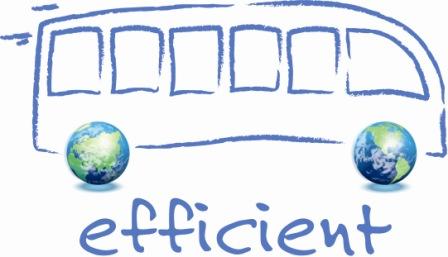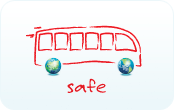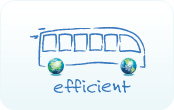// Bus and coach terminals and stops
|   Bus and coach terminals and stops are the genuine "workshops” where car drivers are converted into passengers. The availability of appropriate bus and coach terminals/stations (i.e. for all cities > 50 000 inhabitants) and linking them into a network throughout Europe (as part of the Trans-European Networks) can transform them into genuine mobility interfaces for both regular and tourist travellers. Coach stations with inter-modal exchange facilities allow larger numbers of passengers to be offered a high quality service and give added value to collective travel by bus and coach. A dense network of bus and coach stations encourages large numbers of potential travellers to opt for sustainable and safe common passenger transport. Typically, a large bus and coach terminal in a large European city welcomes on average 3-5 million passengers per year, thus contributing significantly to facilitating mobility and optimising the transport system. Bus and coach terminals and stops are the genuine "workshops” where car drivers are converted into passengers. The availability of appropriate bus and coach terminals/stations (i.e. for all cities > 50 000 inhabitants) and linking them into a network throughout Europe (as part of the Trans-European Networks) can transform them into genuine mobility interfaces for both regular and tourist travellers. Coach stations with inter-modal exchange facilities allow larger numbers of passengers to be offered a high quality service and give added value to collective travel by bus and coach. A dense network of bus and coach stations encourages large numbers of potential travellers to opt for sustainable and safe common passenger transport. Typically, a large bus and coach terminal in a large European city welcomes on average 3-5 million passengers per year, thus contributing significantly to facilitating mobility and optimising the transport system. Example: At the end of 2008, Stockholm’s largest bus terminal, Cityterminalen, was re-inaugurated following considerable reconstruction aimed at optimising capacity and offering travellers and passenger transport companies enhanced service. Cityterminalen is built on two levels with 19 gates. Around 100 000 buses and coaches from 500 different destinations in Sweden and the rest of Europe arrive and depart annually. Most are for scheduled long distance travel, but a considerable number are also tourist coaches. | For more information: Stockholm City Trophy Application 2009 Study of passenger transport by coach, Final Report, European Commission, pp.64-74
Study of passenger transport by coach, Appendix C: Study of coach terminals, European Commission | // Central and convenient location of bus and coach terminals |   The location of bus and coach terminals is of utmost importance and highly contributes to the role of a terminal as a passenger logistics hub. Being situated next to administrative, trade, cultural and educational centres, as well as close to or integrated with railway stations, sea ports, airports and easy access to urban collective/public means of transport is a tremendous advantage. Furthermore, it should be ensured that enough space for further enlargements is available. Easy and quick access to major highways and streets, serving all directions of coach routes, is essential. The location for the construction of a coach terminal should be chosen according to short and long-term forecasting demand developments. The location of bus and coach terminals is of utmost importance and highly contributes to the role of a terminal as a passenger logistics hub. Being situated next to administrative, trade, cultural and educational centres, as well as close to or integrated with railway stations, sea ports, airports and easy access to urban collective/public means of transport is a tremendous advantage. Furthermore, it should be ensured that enough space for further enlargements is available. Easy and quick access to major highways and streets, serving all directions of coach routes, is essential. The location for the construction of a coach terminal should be chosen according to short and long-term forecasting demand developments.
Example:Riga International Coach Terminal is centrally located and nowadays offers sufficient capacity. The Riga International Coach Terminal provides services to regional, long-distance and international routes. On average, it offers services to 510 local and 60 international routes per day. Every year, 5–6 million passengers pass through the terminal. Nevertheless, a new coach terminal for Riga is under construction as the increasing demand for bus and coach services and insufficient space to enlarge the coach terminal would not allow the existing terminal to operate efficiently in the future. | For more information: Riga International Coach Terminal Study of passenger transport by coach, Appendix C: Study of coach terminals, European Commission Study of passenger transport by coach, Final Report, European Commission Coach terminal as important element of transport infrastructure, Vaira Gromule, Irina Yatskiv | // Fast and easy accessibility to terminals |  Passengers of coach and bus services using coach terminals for their travel want to reach their bus/coach as easy and quickly as possible. That is why coach terminals should be well planned to offer customers smooth and rapid usage of the services offered. Passengers of coach and bus services using coach terminals for their travel want to reach their bus/coach as easy and quickly as possible. That is why coach terminals should be well planned to offer customers smooth and rapid usage of the services offered.
Easy access possibilities for buses and coaches have to be ensured through access roads, locations of boarding and disembarking platforms and possibilities of parking between routes and space for coach manoeuvring. Furthermore, pedestrians, cyclists, taxis, car users and passengers of collective/public transport need to have easy access to terminals. This can be ensured by the creation of access roads, pavements, crossings, parking spaces and the rationale organisation of boarding and disembarking procedures and areas. In addition to coaches and other users, passengers who depart or arrive at the coach terminal must have barrier-free access to the terminal: A sufficient number of entrances and exits, passenger flow management to/from and along the platforms and access to coaches in order to board and disembark are essential. Moreover, enough space for luggage loading has to be available and assistance services for people with reduced mobility must be offered. | // Comfort and facility for passengers |  Passengers of coaches and buses using coach terminals expect a certain level of quality from the on-site facilities. Comfortable equipment and a pleasing environment increase customer satisfaction. Passengers of coaches and buses using coach terminals expect a certain level of quality from the on-site facilities. Comfortable equipment and a pleasing environment increase customer satisfaction.
The quality of air should be good and the temperature should be pleasant in the coach terminal. Therefore, air-condition and/or heating systems have to be installed. Furthermore, regular maintenance to ensure a clean environment has to be arranged. Lighting and noise isolation also play an important role. In addition to this, waiting rooms should be equipped with comfortable seating and catering possibilities. Hygiene facilities, for example toilets and showers are an absolute must. Moreover, communication possibilities, catering and shops should be part of an efficient coach terminal. Other facilities and services which increase the terminal’s attractiveness are: Hotspots and Web terminals, cash machines, left luggage lockers, lost & found and post offices. Additionally, facilities for bus drivers, such as showers, toilets, lounges and resting rooms, should be on hand and available for drivers from all operators. | | // Right of access to terminals |  Coach operators trying to access terminals should be granted more support and equal rights in terms of regulations. Coach operators should be able to apply for slots at regular intervals in order to give new operators an opportunity to enter the markets and to benefit from major traffic flows during peak times. Coach operators trying to access terminals should be granted more support and equal rights in terms of regulations. Coach operators should be able to apply for slots at regular intervals in order to give new operators an opportunity to enter the markets and to benefit from major traffic flows during peak times. Extended facilities, including for customers and drivers as well as for ticketing, should be offered for buses and coaches at existing railway stations and airports, thus transforming them into genuine multimodal interfaces. | // Independent management of coach terminals |   At coach terminals where a vertical integration between coach and terminal operators is to be found, systems and regulations guaranteeing all operators equal rights to operate from the terminal would bring operators and their passengers additional benefits. At coach terminals where a vertical integration between coach and terminal operators is to be found, systems and regulations guaranteeing all operators equal rights to operate from the terminal would bring operators and their passengers additional benefits.
Example: The Brasov coach terminal in Romania is managed and organised by a public & private partnership. The Brasov municipality financed the construction of a coach terminal with a total investment of €2.5 million. This new terminal is connected to local transport services, houses a police station, a guarded parking area for 140 cars, a waiting room for passengers, ticket offices, an information office, a duty doctor and 30 commercial spaces on two floors (total surface of 2,200 square meters). Reportedly, new entrants are enthusiastic about the Brasov terminal, as the terminal management ensures independence and equal access rights for all. | // Permanent bus and coach lanes |   Permanent bus and coach lanes are dedicated to buses and coaches during the whole day. These lanes might be combined with special traffic signals which give buses and coaches complete priority and, as a result, make the bus/coach as efficient as a tram using a dedicated infrastructure. Other vehicles, such as taxis, might be allowed to use these dedicated lanes as well. Permanent bus and coach lanes are dedicated to buses and coaches during the whole day. These lanes might be combined with special traffic signals which give buses and coaches complete priority and, as a result, make the bus/coach as efficient as a tram using a dedicated infrastructure. Other vehicles, such as taxis, might be allowed to use these dedicated lanes as well.
Example: Lille has introduced a high quality service bus route which has made collective/public transport popular amongst commuters and has reduced traffic in the city centre. The combination of bus/coach lanes, priority at junctions for buses/coaches and park and ride facilities have made this possible. Example: The city of Stockholm allows visiting tourist coaches to use dedicated public transport lines, whilst at the same time offering some 40 dedicated coach parking spaces close to touristic sites. In Coventry (UK), Primelines is an impressive partnership project delivering high quality bus infrastructure and services to increase bus patronage across the city. It includes 5.3 km of bus lanes, plus 4.9 km of red routes, 13 new bus gates and bus bypasses to allow buses to overtake stationary traffic, 70 new bus shelters with seating and real-time information, 19 new bus stop flags with real-time information displays, and 80 new traffic signals equipped for bus priority, supported by clever marketing including personalised journey and travel planning. In each of the Primelines corridors, research is undertaken as to how the bus reliability and journey times could be improved. Consideration is given as to whether any of the following measures could be introduced onto the corridor: - Bus Lanes & Bus Bypasses
- Bus Priority Measures (such as bus gates)
- New Bus Stops/Shelters/Boarders
- New parking facilities and restrictions (such as red routes)
- Improved traffic signals/roundabouts
- New landscaped areas
- Improved cycling facilities
- Improved pedestrian facilities
- Provision of Real-Time Passenger Information & CCTV Cameras
Early results are impressive, showing that 47% of householders have changed their travel behaviour, 39% of householders have reduced the amount they have driven, with 24% using the bus more frequently. | For more information: Sustainable Urban Transport, Final report from the European project Trendsetter, pp. 16-17 LilleMétropole, France – Mini-Case study, presentation by Kate Theobald, Northumbria University Stockholm Visitors Board Coventry | // Flexible bus/coach lanes |  Flexible bus/coach lanes exist in various forms. They may be reserved for buses/coaches only during peak traffic hours or the direction of motion could change according to the main traffic flow. Such bus/coach lanes can be dedicated only to buses/coaches, or also to taxis and vehicles with more than two occupants. Flexible bus/coach lanes exist in various forms. They may be reserved for buses/coaches only during peak traffic hours or the direction of motion could change according to the main traffic flow. Such bus/coach lanes can be dedicated only to buses/coaches, or also to taxis and vehicles with more than two occupants. Example: In 1992, Madrid introduced a 16 km flexible bus lane “BUS VAO” on a highway connecting the suburbs to the city itself. The bus lane consists of two sections. While the first section in the suburbs is for both buses and vehicles with more than two occupants, the second part, which is 3.8 km long, is only reserved for buses and coaches. The bus lane is reversible and functions according to the bigger traffic flow demand. (Morning: Suburbs-Madrid; After 14:00: Madrid-suburbs). More than 15 years of operation has proven “BUS VAO” to be an efficient service. With 21 routes, about 252 buses make use of the lane during peak hours. The share of people taking buses from the suburbs into the city centre increased from 17% in 1991 to 28% in 2007. | For more information: Lignes Express Inter-villes et nationales, site propre autoroutier pour autobus, l’expérience espagnole The intermittent bus lane system, demonstration in Lisbon BRT in Europe: Bus of High Level of Service, Cities for Mobility World Congress, Stuttgart BHLS, Buses with High Level of Service Buses with a high level of service, an opportunity for mobility in the city | // Bus and coach only street |   In the city of Rouen in Normandy a “BHLS” (Bus of High Level of Service) system was put in operation. Three bus lines use streets which are dedicated to bus traffic only In the city of Rouen in Normandy a “BHLS” (Bus of High Level of Service) system was put in operation. Three bus lines use streets which are dedicated to bus traffic only. This allows better service and higher punctuality for customers. | // Priority to buses and coaches at junctions |   Through dynamic bus/coach priority systems, which give buses and coaches priority at intersections, travelling by bus and coach is getting faster. Such computer-driven systems reduce delays at traffic lights and raise the average speed. Through dynamic bus/coach priority systems, which give buses and coaches priority at intersections, travelling by bus and coach is getting faster. Such computer-driven systems reduce delays at traffic lights and raise the average speed. Example: Within Trendsetter (European Environmental Project), Prague and Stockholm have introduced such systems. Experience has shown that traffic signal control needs to be an integrated part of traffic management. The city of Manchester registered an increase of 28% in bus passengers of one bus service after frequencies were doubled and bus priority measures, including at junctions, were introduced. | For more information: Sustainable Urban Transport, Final report from the European project Trendsetter, pp. 16-17 The way ahead, bus priority, Department for Transport UK Moving forward, New opportunities, new passengers, CPT, pp.16-17 | // Construction of park & ride facilities |    Park & ride facilities, situated next to major bus and coach routes in the suburbs, attract more people from the countryside to leave their cars outside the city and alternatively use collective/public means of transport to reach their final destination in the city. Park & ride services offered at lower prices than inner-city parking are more likely to succeed. Park & ride facilities, situated next to major bus and coach routes in the suburbs, attract more people from the countryside to leave their cars outside the city and alternatively use collective/public means of transport to reach their final destination in the city. Park & ride services offered at lower prices than inner-city parking are more likely to succeed.
Example: In 2001, Cambridgeshire, in co-operation with Stagecoach, introduced a new strategy based on park & ride facilities, a new fleet, bus priority measures, a new fare structure and marketing campaigns. As a result of these measures, Cambridgeshire was able to increase its passenger volume by 77% from 2001 to 2006. | For more information: CIVITAS 1 Cross site evaluation, METEOR deliverable 6, p.129 Moving Forward, new opportunities, new passengers, cpt, pp.10-11 Park & Ride, Cambridgeshire County Council | // Creation of parking facilities for visiting tourist coaches |   Parking, stopping and waiting spaces for tourist coaches must be available in order to give coach tourism groups easy access to hotels, touristic sites, shops and other tourist facilities located in the cities. Parking, stopping and waiting spaces for tourist coaches must be available in order to give coach tourism groups easy access to hotels, touristic sites, shops and other tourist facilities located in the cities. Example: Stockholm, the winner of the IRU City Trophy 2009, boasts parking areas at all city entrances, whilst at the same time offering some 40 dedicated coach parking spaces close to touristic sites. At Leith near Edinburgh, the royal yacht Britannia has proved a hugely popular visitor attraction. Group visits are welcomed and offer scheduled tours of the ship as well as access to the visitor centre and the adjacent Ocean Terminal shopping centre. To facilitate this, a dedicated coach pick-up and drop-off point and a nearby free coach parking area have been established. | For more information: The Coach Parking and Guidance System of the City of Dresden Bremen, Application for the 2009 IRU City Trophy Award Stockholm, Application for the IRU City Trophy Stockholm Visitors Board | // Development of guidance systems for visiting tourist coaches |   Guidance systems, such as in Dresden, Bremen or in Leipzig, make it easier for visiting coach drivers to find their way around the city, by using different colours for hotels, tourist attractions and public facilities. In addition, leaflets and Internet sites, which indicate access routes and coach parking areas, facilitate the coach driver’s orientation. Guidance systems, such as in Dresden, Bremen or in Leipzig, make it easier for visiting coach drivers to find their way around the city, by using different colours for hotels, tourist attractions and public facilities. In addition, leaflets and Internet sites, which indicate access routes and coach parking areas, facilitate the coach driver’s orientation. | For more information: Leipzig, IRU City Trophy Award 2005 Dresden, IRU City Trophy Award 2005 Bremen, IRU City Trophy Award 2009 | // 24 hours coach service centres |   24-hour coach maintenance services must be available, including cleaning and washing facilities, rubbish and toilet waste disposals, repair work and refuelling facilities, to ensure good quality service and attract more customers. 24-hour coach maintenance services must be available, including cleaning and washing facilities, rubbish and toilet waste disposals, repair work and refuelling facilities, to ensure good quality service and attract more customers.
Example: Together with Bremer Strassenbahn AG (BSAG), the city of Bremen offers a 24-hour maintenance service for coaches. This includes facilities for washing the exterior, interior cleaning, disposal of rubbish and toilet waste, engine wash, re-fuelling and other repair works. |
|
|














